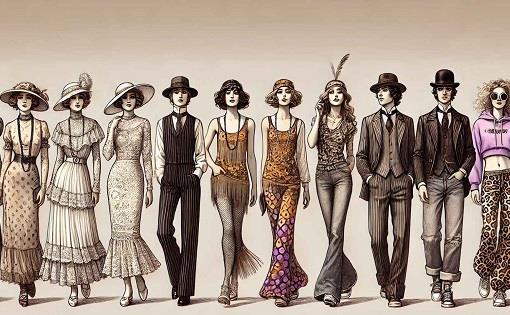The Evolution of Fashion Illustration Over the Years

Fashion illustration is a form of art that has continually adapted to the changing tastes of society, reflecting the ever-evolving nature of both art and fashion itself. What began as simple sketches to represent clothing designs has transformed into a vibrant, intricate art form that transcends time and trend. The journey of illustration evolution trends has been one marked by significant shifts, from the delicate hand-drawn sketches of the past to the dynamic digital renderings of today.
The Early Days: Fashion Art History in the Making
In the early years of fashion illustration, artists were primarily tasked with documenting designs for high society and royal courts. The mid-18th century saw the first real use of fashion art history, with artists like Jean-Étienne Liotard creating detailed and elegant portraits that captured the essence of fashion. These early illustrations were used to showcase the latest clothing styles, often tailored to the wealthy elite, and were more akin to portraiture than what we think of today as fashion illustration.
As the 19th century progressed, the advent of fashion magazines brought about a shift. Publications like Le Follet and Harper’s Bazaar began to feature illustrations alongside written descriptions, offering a visual representation of the latest trends. This was a crucial moment in the sketching through the years, as illustrators became more integral to the fashion industry. No longer just documenters, these artists began to showcase their own interpretations of fashion, influencing how the public viewed style. It was during this time that iconic illustrators like Charles Dana Gibson and Georges Lepape emerged, refining the craft and creating beautiful, detailed works that not only showed the clothing but also conveyed mood and personality.
The Golden Age of Fashion Illustration
The early 20th century marked the illustration over time as a golden age of fashion. The influence of artists like René Gruau, who worked with the legendary fashion house Christian Dior, revolutionized the way fashion was represented. These illustrations were bold, graphic, and full of energy. They captured the movement, luxury, and sophistication of haute couture, often pushing the boundaries of realism. In fact, many of these illustrations became so iconic that they were not only used in fashion magazines but also found their way into advertising campaigns and store windows.
Fashion illustration during this period was also deeply intertwined with the art deco movement, which favored geometric shapes and sleek lines. The combination of fashion with the exuberant art styles of the time created an entirely new visual language, one that was immediately recognizable and celebrated worldwide. Sketching through the years during the 1920s and 1930s thus became more than just a medium for fashion; it became an art form in itself, with fashion illustrators celebrated alongside painters and sculptors.
The Shift to Photography
By the mid-20th century, the rise of photography began to change the landscape of fashion illustration. With the increased use of photographic images in magazines and advertising, illustrators found their work less in demand. However, the mid-century modern era saw illustrators adapt by incorporating photography into their designs, blending the two mediums to create fresh visual statements.
In particular, fashion illustration became an essential tool in advertising, with artists capturing the mood and aesthetic of the moment. Fashion houses used these illustrations for campaign ads, while magazines like Vogue and Harper’s Bazaar continued to feature them in editorial spreads. While photography had taken center stage, illustration over time proved resilient. The personal touch of a hand-drawn sketch, the ability to exaggerate proportions or highlight fabric textures, remained a unique strength of fashion illustration.
The Digital Revolution
The late 20th and early 21st centuries brought about an entirely new era for fashion illustration with the advent of digital technology. Computer programs like Adobe Illustrator and Photoshop gave illustrators the tools to bring their creative visions to life in ways that were previously unimaginable. The flexibility of digital illustration allowed artists to experiment with colors, textures, and techniques that could easily be edited or refined.
As fashion trends became more accessible through the internet and social media, fashion illustration began to reach a global audience. Digital platforms allowed illustrators to share their work instantly, building communities and collaborations that had never been possible before. Illustration evolution trends moved away from purely high-fashion depictions, embracing a wider range of styles that reflected street fashion, subcultures, and even fantasy. Illustrators now had the freedom to explore different visual styles, from hyper-realistic to abstract, and everything in between.
At the same time, fashion illustration experienced a revival in traditional forms. The blend of digital and hand-drawn illustrations provided new opportunities for designers and artists to create hybrid works, merging the best of both worlds. Artists like David Downton and Megan Hess became leading figures in the fashion illustration scene, fusing modern sensibilities with classic techniques.
Today’s Fashion Illustration Landscape
In today’s fashion world, illustration is enjoying a resurgence, fueled by the growing appreciation for handcrafted, personal, and authentic visual storytelling. Whether in magazines, digital platforms, or the realm of fine art, fashion illustration is an integral part of the style industry. Fashion art history continues to evolve, with emerging artists drawing inspiration from both the masters of the past and the latest trends. Today’s illustrators are not just recording fashion trends; they are creating visionary works that often transcend mere garment representation to become dynamic, emotive pieces of art.
The influence of illustration evolution trends can be seen everywhere, from the viral fashion illustrations on social media to the commissioned works for global brands. This vibrant blend of creativity and style reflects an ever-changing visual culture, one that celebrates the fusion of old and new, tradition and innovation.
Fashion illustration has indeed evolved from simple depictions of clothing to a celebrated art form that mirrors the changing tides of fashion. As illustrators continue to blend various mediums and techniques, sketching through the years shows no sign of slowing down. Whether through traditional methods or digital tools, the timeless charm of fashion illustration remains ever relevant, with its ability to express the spirit of an era, one stroke at a time.

